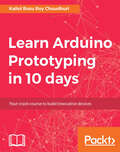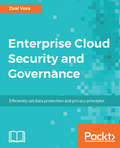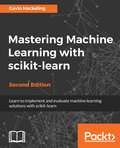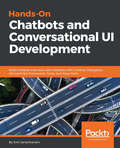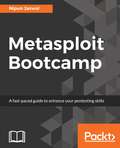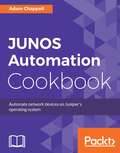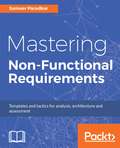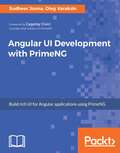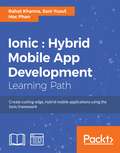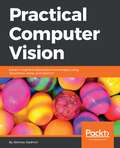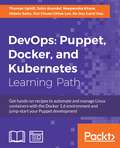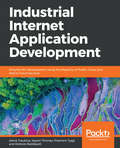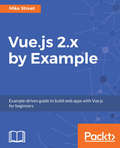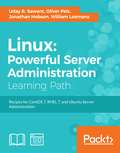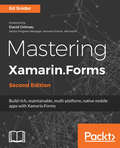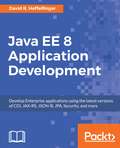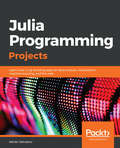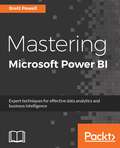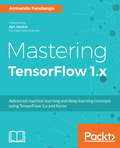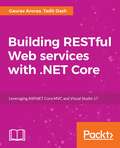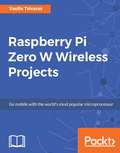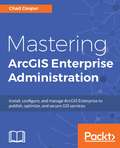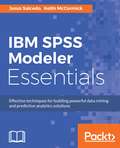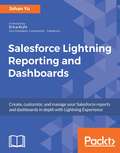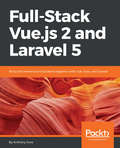- Table View
- List View
Learn Arduino Prototyping in 10 days
by Kallol Bosu ChoudhuriThe ultimate power-packed crash course in building Arduino-based projects in just 10 days! About This Book • A carefully designed 10-day crash course, covering major project/device types, with 20+ unique hands-on examples • Get easy-to-understand explanations of basic electronics fundamentals and commonly used C sketch functions • This step-by-step guide with 90+ diagrams and 50+ important tips will help you become completely self-reliant and confident Who This Book Is For This book is a beginner's crash course for professionals, hobbyists, and students who are tech savvy, have a basic level of C programming knowledge, and basic familiarity with electronics, be it for embedded systems or the Internet of Things. What You Will Learn • Write Arduino sketches and understand the fundamentals of building prototype circuits using basic electronic components, such as resistors, transistors, and diodes • Build simple, compound, and standalone devices with auxiliary storage (SD card), a DC battery, and AC power supplies • Deal with basic sensors and interface sensor modules by using sensor datasheets • Discover the fundamental techniques of prototyping with actuators • Build remote-controlled devices with infrared (IR), radio frequency (RF), and telephony with GSM • Learn IoT edge device prototyping (using ESP8266) and IoT cloud configuration In Detail This book is a quick, 10-day crash course that will help you become well acquainted with the Arduino platform. The primary focus is to empower you to use the Arduino platform by applying basic fundamental principles. You will be able to apply these principles to build almost any type of physical device. The projects you will work through in this book are self-contained micro-controller projects, interfacing with single peripheral devices (such as sensors), building compound devices (multiple devices in a single setup), prototyping standalone devices (powered from independent power sources), working with actuators (such as DC motors), interfacing with an AC-powered device, wireless devices (with Infrared, Radio Frequency and GSM techniques), and finally implementing the Internet of Things (using the ESP8266 series Wi-Fi chip with an IoT cloud platform). The first half of the book focuses on fundamental techniques and building basic types of device, and the final few chapters will show you how to prototype wireless devices. By the end of this book, you will have become acquainted with the fundamental principles in a pragmatic and scientific manner. You will also be confident enough to take up new device prototyping challenges. Style and approach This step-by- step guide will serve as a quick, 10-day crash course to help you become well acquainted with the Arduino platform.
Enterprise Cloud Security and Governance: Efficiently set data protection and privacy principles
by Adrian Pruteanu Zeal VoraKey Features Gain a firm grasp of Cloud data security and governance, irrespective of your Cloud platform Practical examples to ensure you secure your Cloud environment efficiently A step-by-step guide that will teach you the unique techniques and methodologies of Cloud data governance Book Description Modern day businesses and enterprises are moving to the Cloud, to improve efficiency and speed, achieve flexibility and cost effectiveness, and for on-demand Cloud services. However, enterprise Cloud security remains a major concern because migrating to the public Cloud requires transferring some control over organizational assets to the Cloud provider. There are chances these assets can be mismanaged and therefore, as a Cloud security professional, you need to be armed with techniques to help businesses minimize the risks and misuse of business data. The book starts with the basics of Cloud security and offers an understanding of various policies, governance, and compliance challenges in Cloud. This helps you build a strong foundation before you dive deep into understanding what it takes to design a secured network infrastructure and a well-architected application using various security services in the Cloud environment. Automating security tasks, such as Server Hardening with Ansible, and other automation services, such as Monit, will monitor other security daemons and take the necessary action in case these security daemons are stopped maliciously. In short, this book has everything you need to secure your Cloud environment with. It is your ticket to obtain industry-adopted best practices for developing a secure, highly available, and fault-tolerant architecture for organizations. What you will learn Configure your firewall and Network ACL Protect your system against DDOS and application-level attacks Explore cryptography and data security for your cloud Get to grips with configuration management tools to automate your security tasks Perform vulnerability scanning with the help of the standard tools in the industry Learn about central log management
Mastering Machine Learning with scikit-learn - Second Edition
by Gavin HackelingUse scikit-learn to apply machine learning to real-world problems About This Book • Master popular machine learning models including k-nearest neighbors, random forests, logistic regression, k-means, naive Bayes, and artificial neural networks • Learn how to build and evaluate performance of efficient models using scikit-learn • Practical guide to master your basics and learn from real life applications of machine learning Who This Book Is For This book is intended for software engineers who want to understand how common machine learning algorithms work and develop an intuition for how to use them, and for data scientists who want to learn about the scikit-learn API. Familiarity with machine learning fundamentals and Python are helpful, but not required. What You Will Learn • Review fundamental concepts such as bias and variance • Extract features from categorical variables, text, and images • Predict the values of continuous variables using linear regression and K Nearest Neighbors • Classify documents and images using logistic regression and support vector machines • Create ensembles of estimators using bagging and boosting techniques • Discover hidden structures in data using K-Means clustering • Evaluate the performance of machine learning systems in common tasks In Detail Machine learning is the buzzword bringing computer science and statistics together to build smart and efficient models. Using powerful algorithms and techniques offered by machine learning you can automate any analytical model. This book examines a variety of machine learning models including popular machine learning algorithms such as k-nearest neighbors, logistic regression, naive Bayes, k-means, decision trees, and artificial neural networks. It discusses data preprocessing, hyperparameter optimization, and ensemble methods. You will build systems that classify documents, recognize images, detect ads, and more. You will learn to use scikit-learn's API to extract features from categorical variables, text and images; evaluate model performance, and develop an intuition for how to improve your model's performance. By the end of this book, you will master all required concepts of scikit-learn to build efficient models at work to carry out advanced tasks with the practical approach. Style and approach This book is motivated by the belief that you do not understand something until you can describe it simply. Work through toy problems to develop your understanding of the learning algorithms and models, then apply your learnings to real-life problems.
Hands-On Chatbots and Conversational UI Development: Build chatbots and voice user interfaces with Chatfuel, Dialogflow, Microsoft Bot Framework, Twilio, and Alexa Skills
by Phil D Hall Vamsi Venigalla Srini JanarthanamKey Features Understand the different use cases of Conversational UIs with this project-based guide Build feature-rich Chatbots and deploy them on multiple platforms Get real-world examples of voice-enabled UIs for personal and home assistance Book Description Conversation as an interface is the best way for machines to interact with us using the universally accepted human tool that is language. Chatbots and voice user interfaces are two flavors of conversational UIs. Chatbots are real-time, data-driven answer engines that talk in natural language and are context-aware. Voice user interfaces are driven by voice and can understand and respond to users using speech. This book covers both types of conversational UIs by leveraging APIs from multiple platforms. We'll take a project-based approach to understand how these UIs are built and the best use cases for deploying them. We'll start by building a simple messaging bot from the Facebook Messenger API to understand the basics of bot building. Then we move on to creating a Task model that can perform complex tasks such as ordering and planning events with the newly-acquired-by-Google Dialogflow and Microsoft Bot framework. We then turn to voice-enabled UIs that are capable of interacting with users using speech with Amazon Alexa and Google Home. By the end of the book, you will have created your own line of chatbots and voice UIs for multiple leading platforms. What you will learn Design the flow of conversation between the user and the chatbot Create Task model chatbots for implementing tasks such as ordering food Get new toolkits and services in the chatbot ecosystem Integrate third-party information APIs to build interesting chatbots Find out how to deploy chatbots on messaging platforms Build a chatbot using MS Bot Framework See how to tweet, listen to tweets, and respond using a chatbot on Twitter Publish chatbots on Google Assistant and Amazon Alexa
Metasploit Bootcamp
by Nipun JaswalMaster the art of penetration testing with Metasploit Framework in 7 days About This Book • A fast-paced guide that will quickly enhance your penetration testing skills in just 7 days • Carry out penetration testing in complex and highly-secured environments. • Learn techniques to Integrate Metasploit with industry's leading tools Who This Book Is For If you are a penetration tester, ethical hacker, or security consultant who quickly wants to master the Metasploit framework and carry out advanced penetration testing in highly secured environments then, this book is for you. What You Will Learn • Get hands-on knowledge of Metasploit • Perform penetration testing on services like Databases, VOIP and much more • Understand how to Customize Metasploit modules and modify existing exploits • Write simple yet powerful Metasploit automation scripts • Explore steps involved in post-exploitation on Android and mobile platforms. In Detail The book starts with a hands-on Day 1 chapter, covering the basics of the Metasploit framework and preparing the readers for a self-completion exercise at the end of every chapter. The Day 2 chapter dives deep into the use of scanning and fingerprinting services with Metasploit while helping the readers to modify existing modules according to their needs. Following on from the previous chapter, Day 3 will focus on exploiting various types of service and client-side exploitation while Day 4 will focus on post-exploitation, and writing quick scripts that helps with gathering the required information from the exploited systems. The Day 5 chapter presents the reader with the techniques involved in scanning and exploiting various services, such as databases, mobile devices, and VOIP. The Day 6 chapter prepares the reader to speed up and integrate Metasploit with leading industry tools for penetration testing. Finally, Day 7 brings in sophisticated attack vectors and challenges based on the user's preparation over the past six days and ends with a Metasploit challenge to solve. Style and approach This book is all about fast and intensive learning. That means we don't waste time in helping readers get started. The new content is basically about filling in with highly-effective examples to build new things, show solving problems in newer and unseen ways, and solve real-world examples.
JUNOS Automation Cookbook
by Adam ChappellAdminister, configure, and monitor Junos in your organization About This Book • Get well acquainted with security and routing policies to identify the use of firewall filters. • Learn to provide end-user authentication and protect each layer in an enterprise network. • A recipe-based guide that will help you configure and monitor Junos OS and basic device operations. Who This Book Is For This book targets network engineers, developers, support personals, and administrators who are working on devices running Junos OS and are looking at automating their organisation's operations. Some understanding about Junos would be necessary What You Will Learn • Start using NETCONF RPC standard and understand its usefulness in programming JUNOS • Write SLAX scripts to respond to events in the JUNOS environment • Automate JUNOS with PyEZ • Deal with events in the JUNOS environment, and writing response handlers to deal with them • Make the most of automation technologies to help with maintenance and monitoring of JUNOS • Use the Ansible framework to extend the automation functionality of Junos In Detail The JUNOS Automation Cookbook is a companion guide for the complex field of automating tasks on JUNOS devices. With a foundation in industry-standrd XML, JUNOS provides an ideal environment for programmatic interation, allowing you to build upon the capabilities provided by Juniper, with your own original code. You will begin by learning about, and setting up, the industry-standard NETCONF remote procedure call mechanisms on your device. After initial setup, you'll walk through SLAX - Juniper's foundation scripting language - for manipulating XML representations of JUNOS concepts and elements. You'll learn how to write your own SLAX scripts to customise the operating environment, and also how to write proactive event handlers that deal with situations as they happen. You'll then delve into PyEZ - Juniper's bridging framework to make automation accessible to Python code - allowing you to build automation applications in the popular scripting language. You'll witness some examples of how to write applications that can monitor configuration changes, implement BGP security policies and implement ad-hoc routing protocols, for those really tricky situations. You'll also leaarn how asynchronous I/O frameworks like Node.js can be used to implement automation applications that present an acceptable web interface. Along with way, you'll explore how to make use of the latest RESTful APIs that JUNOS provides, how to visualize aspects of your JUNOS network, and how to integrate your automation capabilities with enterprise-wide orchestration systems like Ansible. By the end of the book, you'll be able to tackle JUNOS automation challenges with confidence and understanding, and without hassle. Style and Approach A guide that will cover all the automation tools along with steps on leveraging these tools
Mastering Non-Functional Requirements
by Sameer ParadkarThis book covers the most critical 24 NFRs that are applicable to IT applications and systems. About This Book • Explains three stages of nonfunctional requirements, that is, analysis, architecture, and assessment • In-depth knowledge of NFR framework and taxonomy that provides guidance around the modelling phase for the NFRs • Coverage of 24 critical and pivotal NFRs, including the analysis, architecture, and assessment. Who This Book Is For The primary audience for this title are the gamut of roles starting from IT consultant to chief architects who are responsible to deliver strategic, tactical, and operational engagements for fortune 100 customers worldwide. Nonfunctional requirements are the key to any software / IT program. They cannot be overlooked or ignored. The book provides a comprehensive approach from analysis, architecture, and measurement of nonfunctional requirements. The book includes considerations for bespoke (Java, .Net, and COTS applications). These are applicable to IT applications from various domains. The book outlines the methodology for capturing the NFRs and also describes a framework that can be leveraged by analysts and architects for tackling NFRs for various engagements. The audience for this book include business analysts, enterprise architects, business architects, solution architects, technical architects/designers, domain/security/integration architects, software developers, support engineers and test engineers, technical project managers, project leads/technical leads/technical project managers, and students from the computer science/IT stream What You Will Learn • Learn techniques related to the analysis, architecture, and monitoring of NFRs • Understand the various tools, techniques, and processes in order to improve the overall quality of the desired outcomes • Embrace the best practices of architecting, metrics, and success factors for NFRs • Identify the common pitfalls to be avoided and the patterns to leverage • Understand taxonomy and framework for NFRs • Learn the design guidelines for architecting applications and systems relating to NFRs • Abstract different methodologies to analyze and gather NFRs In Detail Non-functional Requirements are key to any software/IT program and cannot be overlooked or ignored. This book provides a comprehensive approach to the analysis, architecture, and measurement of NFRs. It includes considerations for bespoke Java, .NET, and COTS applications that are applicable to IT applications/systems in different domains. The book outlines the methodology for capturing the NFRs and also describes a framework that can be leveraged by analysts and architects for tackling NFRs for various engagements. This book starts off by explaining the various KPIs, taxonomies, and methods for identifying NFRs. Learn the design guidelines for architecting applications and systems relating to NFRs and design principles to achieve the desired outcome. We will then move on to various key tiers/layers and patterns pertaining to the business, database, and integrating tiers. After this, we will dive deep into the topics pertaining to techniques related to monitoring and measurement of NFRs, such as sizing, analytical modeling, and quality assurance. Lastly, we end the book by describing some pivotal NFRs and checklists for the software quality attributes related to the business, application, data, and infrastructure domains. Style and approach The book takes a pragmatic approach, describing various techniques related to the analysis of NFRs, the architecture of NFRs, and assessment of NFRs.
Angular UI Development with PrimeNG
by Sudheer Jonna Oleg VaraksinUnleash the power of PrimeNG components to design compelling user interface for your Angular applications About This Book • Detailed insights into PrimeNG concepts, components and features with examples to help you make excellent User Interfaces for Angular web apps. • Get familiar with themes, layouts and customization in real world applications. • Develop Angular applications rapidly using advance tools and standards with best practices. Who This Book Is For This book is for everybody who would like to learn or create modern Angular based single page applications using PrimeNG component library. This book is a good choice for beginners to advanced users who are serious to learn modern Angular applications. The prerequisites for this book are some basic knowledge on the Angular 2+ version with TypeScript and CSS skills. What You Will Learn • Setup PrimeNG projects with SystemJS, Webpack, and Angular CLI. • Use theming concepts and layouts with grid systems and Bootstrap. • Work with enhanced input, select, button and panel components. • Apply countless DataTable features: sorting, filtering, grouping, and templating. • Meet data iteration components: DataList, DataGrid, Tree, and so on. • Build endless menu variations: SlideMenu, TieredMenu, MegaMenu, and so on. • Visualize your data representations with PrimeNG charts and GMap components. • Adopt best practices such as state management with @ngrx/store. • Write unit and end-to-end tests with Jasmine, Karma, and Protractor. In Detail PrimeNG is a leading UI component library for Angular applications with 80+ rich UI components. PrimeNG was a huge success in the Angular world and very quickly. It is a rapidly evolving library that is aligned with the last Angular release. In comparison with competitors, PrimeNG was created with enterprise applications in mind. This book provides a head-start to help readers develop real–world, single-page applications using the popular development stack. This book consists of 10 chapters and starts with a short introduction to single-page applications. TypeScript and Angular fundamentals are important first steps for subsequent PrimeNG topics. Later we discuss how to set up and configure a PrimeNG application in different ways as a kick-start. Once the environment is ready then it is time to learn PrimeNG development, starting from theming concepts and responsive layouts. Readers will learn enhanced input, select, button components followed by the various panels, data iteration, overlays, messages and menu components. The validation of form elements will be covered too. An extra chapter demonstrates how to create map and chart components for real-world applications. Apart from built-in UI components and their features, the readers will learn how to customize components to meet their requirements. Miscellaneous use cases are discussed in a separate chapter, including: file uploading, drag and drop, blocking page pieces during AJAX calls, CRUD sample implementations, and more. This chapter goes beyond common topics, implements a custom component, and discusses a popular state management with @ngrx/store. The final chapter describes unit and end-to-end testing. To make sure Angular and PrimeNG development are flawless, we explain full-fledged testing frameworks with systematic examples. Tips for speeding up unit testing and debugging Angular applications end this book. The book is also focused on how to avoid some common pitfalls, and shows best practices with tips and tricks for efficient Angular and PrimeNG development. At the end of this book, the readers will know the ins and outs of how to use PrimeNG in Angular applications and will be ready to create real- world Angular applications using rich PrimeNG components. Style and approach Step-by-step practical approach
Ionic: Hybrid Mobile App Development
by Hoc Phan Rahat Khanna Sani YusufAn end–to-end journey, empowering you to build real-time, scalable, and interactive mobile applications with the Ionic framework About This Book • Develop engaging mobile experiences with a native-looking UI in Ionic and AngularJS. • Use out-of-the-box Ionic functionalities, customize existing components, and add new components with this comprehensive course. • Learn Ionic by creating three complete mobile applications Who This Book Is For If you are a web developer who wants to build hybrid mobile app development using the Ionic framework, then this comprehensive course is best-suited for you. What You Will Learn • Get to know about Hybrid Apps and AngularJS • Set up a development environment to build Hybrid Apps • Navigate around components and routing in Ionic • Authenticate users using an e-mail password, Twitter, Facebook, Google+, and LinkedIn • Retrieve data and store it using Firebase • Access native device functionalities such as the camera, contact list, e-mail, and maps using NG-Cordova • Integrate PhoneGap plugins with NG-Cordova • Test your apps to improve and optimize performance In Detail Hybrid Apps are a promising choice in mobile app development to achieve cost-effectiveness and rapid development. Ionic has evolved as the most popular choice for Hybrid Mobile App development as it tends to match the native experience and provides robust components/tools to build apps. The Ionic Complete Developers course takes you on an end–to-end journey, empowering you to build real-time, scalable, and interactive mobile applications with the Ionic framework. Starting with an introduction to the Ionic framework to get you up and running, you will gradually move on to setting up the environment, and work through the multiple options and features available in Ionic to build amazing hybrid mobile apps. You will learn how to use Cordova plugins to include native functionality in your hybrid apps. You will work through three complete projects and build a basic to-do list app, a London tourist app, and a complete social media app. All three projects have been designed to help you learn Ionic at its very best. From setting up your project to developing on both the server side and front end, and best practices for testing and debugging your projects, you'll quickly be able to deliver high-performance mobile apps that look awesome. You will then hone your skills with recipes for cross-platform development. Integrating Ionic with Cordova will bring you native device features, and you will learn about the best modules from its ecosystem. Creating components and customizing the theme will allow you to extend Ionic. You'll see how to build your app to deploy to all platforms to make you a confident start-to-finish mobile developer. This Learning Path combines some of the best that Packt has to offer in one complete, curated package. It includes content from the following Packt products: • Getting Started with Ionic – by Rahat Khanna • Ionic by Example – by Sani Yusuf • Ionic Cookbook – by Hoc Phan Style and approach This course shows you how to get up and running with the Ionic framework. It doesn't just give you instructions, expecting you to follow them. Instead, with a hands-on approach, it demonstrates what Ionic is capable of through a series of practical projects that you can build yourself.
Practical Computer Vision: Extract Insightful Information From Images Using Tensorflow, Keras, And Opencv
by Abhinav DadhichComputer Vision is a broadly used term associated with acquiring, processing, and analyzing images. This book will show you how you can perform various Computer Vision techniques in the most practical way possible. Right from capturing images from various sources, you will learn how to perform image filtering/manipulation and detect features in your images. As you go through the chapters, you'll work with increasingly complex algorithms to develop complex Computer Vision applications
DevOps: Puppet, Docker, and Kubernetes
by John Arundel Thomas Uphill Neependra Khare Hui-Chuan Chloe Lee Ke-Jou Carol Hsu Hideto Saito<P><P>Get hands-on recipes to automate and manage Linux containers with the Docker 1.6 environment and jump-start your Puppet development <P><P>About This Book <P><P>Successfully deploy DevOps with proven solutions and recipes <P><P>Automate your infrastructure with Puppet and combine powerful DevOps methods <P><P>Deploy and manage highly scalable applications using Kubernetes <P><P>streamline the way you manage your applications <P><P>Who This Book Is For <P><P>This Learning Path is for developers, system administrators, and DevOps engineers who want to use Puppet, Docker, and Kubernetes in their development, QA, or production environments. This Learning Path assumes experience with Linux administration and requires some experience with command-line usage and basic text file editing. <P><P>What You Will Learn <P><P>Discover how to build high availability Kubernetes clusters <P><P>Deal with inherent issues with container virtualization and container concepts <P><P>Create services with Docker to enable the swift development and deployment of applications <P><P>Make optimum use of Docker in a testing environment <P><P>Create efficient manifests to streamline your deployments <P><P>Automate Puppet master deployment using Git hooks, r10k, and PuppetDB <P><P>In Detail <P><P>With so many IT management and DevOps tools on the market, both open source and commercial, it's difficult to know where to start. DevOps is incredibly powerful when implemented correctly, and here's how to get it done.This Learning Path covers three broad areas: Puppet, Docker, and Kubernetes. This Learning Path is a large resource of recipes to ease your daily DevOps tasks. We begin with recipes that help you develop a complete and expert understanding of Puppet's latest and most advanced features. Then we provide recipes that help you efficiently work with the Docker environment. Finally, we show you how to better manage containers in different scenarios in production using Kubernetes.
Industrial Internet Application Development: Simplify IIoT development using the elasticity of Public Cloud and Native Cloud Services
by Alena Traukina Jayant Thomas Prashant Tyagi Kishore ReddipalliYour one-stop guide to designing, building, managing, and operating Industrial Internet of Things (IIoT) applicationsKey FeaturesBuild IIoT applications and deploy them on Platform as a Service (PaaS)Learn data analytics techniques in IIoT using Spark and TensorFlowUnderstand and combine Predix services to accelerate your developmentBook DescriptionThe Industrial Internet refers to the integration of complex physical machines with networked sensors and software. The current growth in the number of sensors deployed in heavy machinery and industrial equipment will lead to an exponential increase in data being captured that needs to be analyzed for predictive analytics. This also opens up a new avenue for developers who want to build exciting industrial applications. Industrial Internet Application Development serves as a one-stop guide for software professionals wanting to design, build, manage, and operate IIoT applications. You will develop your first IIoT application and understand its deployment and security considerations, followed by running through the deployment of IIoT applications on the Predix platform. Once you have got to grips with what IIoT is, you will move on to exploring Edge Development along with the analytics portions of the IIoT stack. All this will help you identify key elements of the development framework, and understand their importance when considering the overall architecture and design considerations for IIoT applications. By the end of this book, you will have grasped how to deploy IIoT applications on the Predix platform, as well as incorporate best practices for making fault-tolerant and reliable IIoT systems.What you will learnConnect prototype devices to CloudStore data in IIoT applications Explore data management techniques and implementationStudy IIoT applications analytics using Spark ML and TensorFlow Deploy analytics and visualize the outcomes as AlertsUnderstand continuous deployment using Docker and Cloud FoundryMake your applications fault-tolerant and monitor them with New RelicUnderstand IIoT platform architecture and implement IIoT applications on the platformWho this book is forThis book is intended for software developers, architects, product managers, and executives keen to gain insights into Industrial Internet development. A basic knowledge of any popular programming language such as Python will be helpful.
Vue.js 2.x by Example: Example-driven guide to build web apps with Vue.js for beginners
by Bogdan-Alin Bâlc Silva Pablo Henrique Penha Mike StreetKey Features We bridge the gap between "learning" and "doing" by providing real-world examples that will improve your web development skills with Vue.js Explore the exciting features of Vue.js 2 through practical and interesting examples Explore modern development tools and learn how to utilize them by building applications with Vue.js Book Description Vue.js is a frontend web framework which makes it easy to do just about anything, from displaying data up to creating full-blown web apps, and has become a leading tool for web developers. This book puts Vue.js into a real-world context, guiding you through example projects that helps you build Vue.js applications from scratch. With this book, you will learn how to use Vue.js by creating three Single Page web applications. Throughout this book, we will cover the usage of Vue, for building web interfaces, Vuex, an official Vue plugin which makes caching and storing data easier, and Vue-router, a plugin for creating routes and URLs for your application. Starting with a JSON dataset, the first part of the book covers Vue objects and how to utilize each one. This will be covered by exploring different ways of displaying data from a JSON dataset. We will then move on to manipulating the data with filters and search and creating dynamic values. Next, you will see how easy it is to integrate remote data into an application by learning how to use the Dropbox API to display your Dropbox contents in an application In the final section, you will see how to build a product catalog and dynamic shopping cart using the Vue-router, giving you the building blocks of an e-commerce store. What you will learn Looping through data with Vue.js Searching and filtering data Using components to display data Getting a list of files using the dropbox API Navigating through a file tree and loading folders from a URL Caching with Vuex Pre-caching for faster navigation Introducing vue-router and loading components Using vue-router dynamic routes to load data Using vue-router and Vuex to create an ecommerce store
Linux: Powerful Server Administration
by Jonathan Hobson William Leemans Oliver Pelz Uday R. SawantGet hands-on recipes to make the most of Ubuntu Server, CentOS 7 Linux Server and RHEL 7 Server About This Book • Get Linux servers up and running in seconds, • In-depth guide to explore new features and solutions in server administration • Maintain performance and security of your server solution by deploying expert configuration advice Who This Book Is For This Learning Path is intended for system administrators with a basic understanding of Linux operating systems and written with the novice-to-intermediate Linux user in mind. To get the most of this Learning Path, you should have a working knowledge of basic system administration and management tools. What You Will Learn • Set up high performance, scalable, and fault-tolerant back ends with web and database servers • Facilitate team communication with a real-time chat service and collaboration tools • Monitor, manage and develop your server's file system to maintain a stable performance • Gain best practice methods on sharing files and resources through a network • Install and configure common standard services such as web, mail, FTP, database and domain name server technologies • Create kickstart scripts to automatically deploy RHEL 7 systems • Use Orchestration and configuration management tools to manage your environment In Detail Linux servers are frequently selected over other server operating systems for their stability, security and flexibility advantages.This Learning Path will teach you how to get up and running with three of the most popular Linux server distros: Ubuntu Server, CentOS 7 Server, and RHEL 7 Server. We will begin with the Ubuntu Server and show you how to make the most of Ubuntu's advanced functionalities. Moving on, we will provide you with all the knowledge that will give you access to the inner workings of the latest CentOS version 7. Finally, touching RHEL 7, we will provide you with solutions to common RHEL 7 Server challenges.This Learning Path combines some of the best that Packt has to offer in one complete, curated package. It includes content from the following Packt products: 1)Ubuntu Server Cookbook 2)CentOS 7 Linux Server Cookbook, Second Edition 3)Red Hat Enterprise Linux Server Cookbook Style and approach This easy-to-follow practical guide contains hands on examples and solutions to real word administration problems and problems faced when building your RHEL 7 system from scratch using orchestration tools.
Mastering Xamarin.Forms: Build rich, maintainable, multi-platform, native mobile apps with Xamarin.Forms, 2nd Edition
by Ed SniderCreate high-quality multi-platform native apps with Xamarin.FormsKey Features Packed with real-world scenarios and solutions to help you build professional-grade mobile apps with Xamarin.Forms Build an effective mobile app architecture with the Xamarin.Forms toolkit Find out how, when, and why you should use architectural patterns and get best practices with Xamarin.FormsBook DescriptionDiscover how to extend and build upon the components of the Xamarin.Forms toolkit to develop an effective, robust mobile app architecture. Starting with an app built with the basics of the Xamarin.Forms toolkit, you'll go step by step through several advanced topics to create a solution architecture rich with the benefits of good design patterns and best practices. You'll start by introducing a core separation between the app's user interface and its business logic by applying the MVVM pattern and data-binding. Then you focus on building out a layer of plugin-like services that handle platform-specific utilities such as navigation and geo-location, and on how to loosely use these services in the app with inversion of control and dependency injection. Next you connect the app to a live web-based API and set up offline synchronization. Then, you delve into testing the app logic through unit tests. Finally, you set up Visual Studio App Center for monitoring usage and bugs to gain a proactive edge on app quality.What you will learn Implement the Model-View-View-Model (MVVM) pattern and data-binding in Xamarin.Forms mobile apps Extend the Xamarin.Forms navigation API with a custom ViewModel-centric navigation service Leverage the inversion of control and dependency injection patterns in Xamarin.Forms mobile apps Work with online and offline data in Xamarin.Forms mobile apps Test business logic in Xamarin.Forms mobile apps Use platform-specific APIs to build rich custom user interfaces in Xamarin.Forms mobile apps Explore how to improve mobile app quality using Visual Studio AppCenterWho this book is forThis book is intended for C# developers who are familiar with the Xamarin platform and the Xamarin.Forms toolkit. If you have already started working with Xamarin.Forms and want to take your app to the next level with higher quality, maintainability, testability, and flexibility, then this book is for you.
Java EE 8 Application Development
by David R. HeffelfingerDevelop Enterprise Java applications compliant with the latest version of the Java EE specification About This Book • This book covers all of the major Java EE 8 APIs and includes new additions such as enhanced Security, JSON-B Processing, and more • Learn additional Java EE APIs, such as the Java API for Websocket and the Java Message Service (JMS) • Develop applications by taking advantage of the latest versions of CDI, Security, Servlets, and JSF and other Java EE specifications Who This Book Is For If you are a Java developer who wants to become proficient with Java EE 8, this book is ideal for you. You are expected to have some experience with Java and to have developed and deployed applications in the past, but you don't need any previous knowledge of Java EE. What You Will Learn • Develop and deploy Java EE applications • Embrace the latest additions to the Contexts and Dependency Injection (CDI) specification to develop Java EE applications • Develop web-based applications by utilizing the latest version of JavaServer Faces, JSF 2.3. • Understand the steps needed to process JSON data with JSON-P and the new JSON-B Java EE API • Implement RESTful web services using the new JAX-RS 2.1 API, which also includes support for Server-Sent Events (SSE) and the new reactive client API In Detail Java EE is an Enterprise Java standard. Applications written to comply with the Java EE specification do not tie developers to a specific vendor; instead they can be deployed to any Java EE compliant application server. With this book, you'll get all the tools and techniques you need to build robust and scalable applications in Java EE 8. This book covers all the major Java EE 8 APIs including JSF 2.3, Enterprise JavaBeans (EJB) 3.2, Contexts and Dependency Injection (CDI) 2.0, the Java API for WebSockets, JAX-RS 2.1, Servlet 4.0, and more. The book begins by introducing you to Java EE 8 application development and goes on to cover all the major Java EE 8 APIs. It goes beyond the basics to develop Java EE applications that can be deployed to any Java EE 8 compliant application server. It also introduces advanced topics such as JSON-P and JSON-B, the Java APIs for JSON processing, and the Java API for JSON binding. These topics dive deep, explaining how the two APIs (the Model API and the Streaming API) are used to process JSON data. Moving on, we cover additional Java EE APIs, such as the Java API for Websocket and the Java Message Service (JMS), which allows loosely coupled, asynchronous communication. Further on, you'll discover ways to secure Java EE applications by taking advantage of the new Java EE Security API. Finally, you'll learn more about the RESTful web service development using the latest JAX-RS 2.1 specification. You'll also get to know techniques to develop cloud-ready microservices in Java EE. Style and approach The book takes a pragmatic approach, showing you various techniques to utilize new features of Java EE 8 specification. It is packed with clear, step-by-step instructions, practical examples, and straightforward explanations.
Julia Programming Projects: Learn Julia 1.x by building apps for data analysis, visualization, machine learning, and the web
by Adrian SalceanuA step-by-step guide that demonstrates how to build simple-to-advanced applications through examples in Julia Lang 1.x using modern tools Key Features Work with powerful open-source libraries for data wrangling, analysis, and visualization Develop full-featured, full-stack web applications Learn to perform supervised and unsupervised machine learning and time series analysis with Julia Book Description Julia is a new programming language that offers a unique combination of performance and productivity. Its powerful features, friendly syntax, and speed are attracting a growing number of adopters from Python, R, and Matlab, effectively raising the bar for modern general and scientific computing. After six years in the making, Julia has reached version 1.0. Now is the perfect time to learn it, due to its large-scale adoption across a wide range of domains, including fintech, biotech, education, and AI. Beginning with an introduction to the language, Julia Programming Projects goes on to illustrate how to analyze the Iris dataset using DataFrames. You will explore functions and the type system, methods, and multiple dispatch while building a web scraper and a web app. Next, you'll delve into machine learning, where you'll build a books recommender system. You will also see how to apply unsupervised machine learning to perform clustering on the San Francisco business database. After metaprogramming, the final chapters will discuss dates and time, time series analysis, visualization, and forecasting. We'll close with package development, documenting, testing and benchmarking. By the end of the book, you will have gained the practical knowledge to build real-world applications in Julia. What you will learn Leverage Julia's strengths, its top packages, and main IDE options Analyze and manipulate datasets using Julia and DataFrames Write complex code while building real-life Julia applications Develop and run a web app using Julia and the HTTP package Build a recommender system using supervised machine learning Perform exploratory data analysis Apply unsupervised machine learning algorithms Perform time series data analysis, visualization, and forecasting Who this book is for Data scientists, statisticians, business analysts, and developers who are interested in learning how to use Julia to crunch numbers, analyze data and build apps will find this book useful. A basic knowledge of programming is assumed.
Mastering Microsoft Power BI: Expert Techniques For Effective Data Analytics And Business Intelligence
by Brett PowellThis book will show you how to use Power BI effectively to create a variety of visualizations and BI dashboards. Right from gathering data through various data sources, you will learn to perform effective visual analytics. By the end of this book, you will be able to gain unique, hidden insights into your data using Microsoft Power BI.
Mastering TensorFlow 1.x: Advanced machine learning and deep learning concepts using TensorFlow 1.x and Keras
by Armando Fandango Nick McClureBuild, scale, and deploy deep neural network models using the star libraries in Python Key Features Delve into advanced machine learning and deep learning use cases using Tensorflow and Keras Build, deploy, and scale end-to-end deep neural network models in a production environment Learn to deploy TensorFlow on mobile, and distributed TensorFlow on GPU, Clusters, and Kubernetes Book Description TensorFlow is the most popular numerical computation library built from the ground up for distributed, cloud, and mobile environments. TensorFlow represents the data as tensors and the computation as graphs. This book is a comprehensive guide that lets you explore the advanced features of TensorFlow 1.x. Gain insight into TensorFlow Core, Keras, TF Estimators, TFLearn, TF Slim, Pretty Tensor, and Sonnet. Leverage the power of TensorFlow and Keras to build deep learning models, using concepts such as transfer learning, generative adversarial networks, and deep reinforcement learning. Throughout the book, you will obtain hands-on experience with varied datasets, such as MNIST, CIFAR-10, PTB, text8, and COCO-Images. You will learn the advanced features of TensorFlow1.x, such as distributed TensorFlow with TF Clusters, deploy production models with TensorFlow Serving, and build and deploy TensorFlow models for mobile and embedded devices on Android and iOS platforms. You will see how to call TensorFlow and Keras API within the R statistical software, and learn the required techniques for debugging when the TensorFlow API-based code does not work as expected. The book helps you obtain in-depth knowledge of TensorFlow, making you the go-to person for solving artificial intelligence problems. By the end of this guide, you will have mastered the offerings of TensorFlow and Keras, and gained the skills you need to build smarter, faster, and efficient machine learning and deep learning systems. What you will learn Master advanced concepts of deep learning such as transfer learning, reinforcement learning, generative models and more, using TensorFlow and Keras Perform supervised (classification and regression) and unsupervised (clustering) learning to solve machine learning tasks Build end-to-end deep learning (CNN, RNN, and Autoencoders) models with TensorFlow Scale and deploy production models with distributed and high-performance computing on GPU and clusters Build TensorFlow models to work with multilayer perceptrons using Keras, TFLearn, and R Learn the functionalities of smart apps by building and deploying TensorFlow models on iOS and Android devices Supercharge TensorFlow with distributed training and deployment on Kubernetes and TensorFlow Clusters Who this book is for This book is for data scientists, machine learning engineers, artificial intelligence engineers, and for all TensorFlow users who wish to upgrade their TensorFlow knowledge and work on various machine learning and deep learning problems. If you are looking for an easy-to-follow guide that underlines the intricacies and complex use cases of machine learning, you will find this book extremely useful. Some basic understanding of TensorFlow is required to get the most out of the book.
Building RESTful Web Services with .NET Core: Developing Distributed Web Services to improve scalability with .NET Core 2.0 and ASP.NET Core 2.0
by Gaurav Aroraa Tadit DashBuilding Complete E-commerce/Shopping Cart ApplicationKey FeaturesFollow best practices and explore techniques such as clustering and caching to achieve a reactive, scalable web serviceLeverage the .NET Framework to quickly implement RESTful endpoints.Learn to implement a client library for a RESTful web service using ASP.NET Core.Book DescriptionREST is an architectural style that tackles the challenges of building scalable web services. In today's connected world, APIs have taken a central role on the web. APIs provide the fabric through which systems interact, and REST has become synonymous with APIs. The depth, breadth, and ease of use of ASP.NET Core makes it a breeze for developers to work with for building robust web APIs. This book takes you through the design of RESTful web services and leverages the ASP.NET Core framework to implement these services. This book begins by introducing you to the basics of the philosophy behind REST. You'll go through the steps of designing and implementing an enterprise-grade RESTful web service. This book takes a practical approach, that you can apply to your own circumstances. This book brings forth the power of the latest .NET Core release, working with MVC. Later, you will learn about the use of the framework to explore approaches to tackle resilience, security, and scalability concerns. You will explore the steps to improve the performance of your applications. You'll also learn techniques to deal with security in web APIs and discover how to implement unit and integration test strategies. By the end of the book, you will have a complete understanding of Building a client for RESTful web services, along with some scaling techniques.What you will learn Add basic authentication to your RESTful API Create a Carts Controller and Orders Controller to manage and process Orders Intercept HTTP requests and responses by building your own middleware Test service calls using Postman and Advanced REST Client Secure your data/application using annotationsWho this book is forThis book is intended for those who want to learn to build RESTful web services with the latest .NET Core Framework. To make best use of the code samples included in the book, you should have a basic knowledge of C# and .NET Core.
Raspberry Pi Zero W Wireless Projects
by Vasilis TzivarasBuild DIY wireless projects using the Raspberry Pi Zero W board About This Book • Explore the functionalities of the Raspberry Pi Zero W with exciting projects • Master the wireless features (and extend the use cases) of this $10 chip • A project-based guide that will teach you to build simple yet exciting projects using the Raspberry Pi Zero W board Who This Book Is For If you are a hobbyist or an enthusiast and want to get your hands on the latest Raspberry Pi Zero W to build exciting wireless projects, then this book is for you. Some prior programming knowledge, with some experience in electronics, would be useful. What You Will Learn • Set up a router and connect Raspberry Pi Zero W to the internet • Create a two-wheel mobile robot and control it from your Android device • Build an automated home bot assistant device • Host your personal website with the help of Raspberry Pi Zero W • Connect Raspberry Pi Zero to speakers to play your favorite music • Set up a web camera connected to the Raspberry Pi Zero W and add another security layer to your home automation In Detail The Raspberry Pi has always been the go–to, lightweight ARM-based computer. The recent launch of the Pi Zero W has not disappointed its audience with its $10 release. "W" here stands for Wireless, denoting that the Raspberry Pi is solely focused on the recent trends for wireless tools and the relevant use cases. This is where our book—Raspberry Pi Zero W Wireless Projects—comes into its own. Each chapter will help you design and build a few DIY projects using the Raspberry Pi Zero W board. First, you will learn how to create a wireless decentralized chat service (client-client) using the Raspberry Pi's features?. Then you will make a simple two-wheel mobile robot and control it via your Android device over your local Wi-Fi network. Further, you will use the board to design a home bot that can be connected to plenty of devices in your home. The next two projects build a simple web streaming security layer using a web camera and portable speakers that will adjust the playlist according to your mood. You will also build a home server to host files and websites using the board. Towards the end, you will create free Alexa voice recognition software and an FPV Pi Camera, which can be used to monitor a system, watch a movie, spy on something, remotely control a drone, and more. By the end of this book, you will have developed the skills required to build exciting and complex projects with Raspberry Pi Zero W. Style and approach A step-by-step guide that will help you design and create simple yet exciting projects using the Raspberry Pi Zero W board.
Mastering ArcGIS Enterprise Administration
by Chad CooperLearn how to confidently install, configure, secure, and fully utilize your ArcGIS Enterprise system. About This Book • Install and configure the components of ArcGIS Enterprise to meet your organization's requirements • Administer all aspects of ArcGIS Enterprise through user interfaces and APIs • Optimize and Secure ArcGIS Enterprise to make it run efficiently and effectively Who This Book Is For This book will be geared toward senior GIS analysts, GIS managers, GIS administrators, DBAs, GIS architects, and GIS engineers that need to install, configure, and administer ArcGIS Enterprise 10.5.1. What You Will Learn • Effectively install and configure ArcGIS Enterprise, including the Enterprise geodatabase, ArcGIS Server, and Portal for ArcGIS • Incorporate different methodologies to manage and publish services • Utilize the security methods available in ArcGIS Enterprise • Use Python and Python libraries from Esri to automate administrative tasks • Identify the common pitfalls and errors to get your system back up and running quickly from an outage In Detail ArcGIS Enterprise, the next evolution of the ArcGIS Server product line, is a full-featured mapping and analytics platform. It includes a powerful GIS web services server and a dedicated Web GIS infrastructure for organizing and sharing your work. You will learn how to first install ArcGIS Enterprise to then plan, design, and finally publish and consume GIS services. You will install and configure an Enterprise geodatabase and learn how to administer ArcGIS Server, Portal, and Data Store through user interfaces, the REST API, and Python scripts. This book starts off by explaining how ArcGIS Enterprise 10.5.1 is different from earlier versions of ArcGIS Server and covers the installation of all the components required for ArcGIS Enterprise. We then move on to geodatabase administration and content publication, where you will learn how to use ArcGIS Server Manager to view the server logs, stop and start services, publish services, define users and roles for security, and perform other administrative tasks. You will also learn how to apply security mechanisms on ArcGIS Enterprise and safely expose services to the public in a secure manner. Finally, you'll use the RESTful administrator API to automate server management tasks using the Python scripting language. You'll learn all the best practices and troubleshooting methods to streamline the management of all the interconnected parts of ArcGIS Enterprise. Style and approach The book takes a pragmatic approach, starting with installation & configuration of ArcGIS Enterprise to finally building a robust GIS web infrastructure for your organization.
IBM SPSS Modeler Essentials: Effective techniques for building powerful data mining and predictive analytics solutions
by Keith McCormick Jose Jesus Salcedo Bowen WeiKey Features Get up–and-running with IBM SPSS Modeler without going into too much depth. Identify interesting relationships within your data and build effective data mining and predictive analytics solutions A quick, easy–to-follow guide to give you a fundamental understanding of SPSS Modeler, written by the best in the business Book Description IBM SPSS Modeler allows users to quickly and efficiently use predictive analytics and gain insights from your data. With almost 25 years of history, Modeler is the most established and comprehensive Data Mining workbench available. Since it is popular in corporate settings, widely available in university settings, and highly compatible with all the latest technologies, it is the perfect way to start your Data Science and Machine Learning journey. This book takes a detailed, step-by-step approach to introducing data mining using the de facto standard process, CRISP-DM, and Modeler’s easy to learn “visual programming” style. You will learn how to read data into Modeler, assess data quality, prepare your data for modeling, find interesting patterns and relationships within your data, and export your predictions. Using a single case study throughout, this intentionally short and focused book sticks to the essentials. The authors have drawn upon their decades of teaching thousands of new users, to choose those aspects of Modeler that you should learn first, so that you get off to a good start using proven best practices. This book provides an overview of various popular data modeling techniques and presents a detailed case study of how to use CHAID, a decision tree model. Assessing a model’s performance is as important as building it; this book will also show you how to do that. Finally, you will see how you can score new data and export your predictions. By the end of this book, you will have a firm understanding of the basics of data mining and how to effectively use Modeler to build predictive models. What you will learn Understand the basics of data mining and familiarize yourself with Modeler’s visual programming interface Import data into Modeler and learn how to properly declare metadata Obtain summary statistics and audit the quality of your data Prepare data for modeling by selecting and sorting cases, identifying and removing duplicates, combining data files, and modifying and creating fields Assess simple relationships using various statistical and graphing techniques Get an overview of the different types of models available in Modeler Build a decision tree model and assess its results Score new data and export predictions
Salesforce Lightning Reporting and Dashboards
by Johan YuLearn how to build advanced reports and dashboards in Salesforce Lightning experience About This Book • Visualize and create advanced reports and dashboards using Lightning Experience • Improve overall business efficiency with advanced and effective reports and dashboards • Understand and create custom reports and dashboards Who This Book Is For This book is targeted at Salesforce.com administrators, business analysts, and managers who use Salesforce.com for their daily job and want to learn in depth about Salesforce Reporting and Dashboard in Lightning Experience. Readers should have a basic knowledge of Salesforce, such as: Accounts, Contacts, Leads, Opportunities and custom objects. What You Will Learn • Navigate in Salesforce.com within the Lightning Experience user interface • Secure and share your reports and dashboards with other users • Create, manage, and maintain reports using Report Builder • Learn how the report type can affect the report generated • Explore the report and dashboard folder and the sharing model • Create reports with multiple formats and custom report types • Explore various dashboard features in Lightning Experience • Use Salesforce1, including accessing reports and dashboards In Detail Built on the Salesforce App Cloud, the new Lightning Experience combines the new Lightning Design System, Lightning App Builder, and Lightning Components to enable anyone to quickly and easily create modern enterprise apps. The book will start with a gentle introduction to the basics of Salesforce reports and dashboards. It will also explain how to access reports in depth. Then you will learn how to create and manage reports, to use Schedule Report, and create advanced report configurations. The next section talks about dashboards and will enable you to understand and compare various types of dashboard component and how you can benefit the most from each of them. Then we move on to advanced topics and explain tips and tricks related to reports and dashboards, including reporting snapshots, report parameters, and collaboration. Finally, we will discuss how to access dashboards and reports from the Salesforce1 mobile app. Style and approach This comprehensive guide covers the advanced features of the all new Salesforce Lightning concepts and communicates them through a practical approach to explore the underlying concepts of how, when, and why to use them.
Full-Stack Vue.js 2 and Laravel 5: Bring the frontend and backend together with Vue, Vuex, and Laravel
by Ashley Menhennett Anthony GoreKey Features End-to-end guide on full-stack development with Vue.js 2 and Laravel 5 Developing modern user interfaces with a reusable component-based architecture Use Webpack to improve applications performance and development workflow Explore the features of Vuex to build applications that are powerful, consistent, and maintainable Book Description Vue is a JavaScript framework that can be used for anything from simple data display to sophisticated front-end applications and Laravel is a PHP framework used for developing fast and secure web-sites. This book gives you practical knowledge of building modern full-stack web apps from scratch using Vue with a Laravel back end. In this book, you will build a room-booking website named "Vuebnb". This project will show you the core features of Vue, Laravel and other state-of-the-art web development tools and techniques. The book begins with a thorough introduction to Vue.js and its core concepts like data binding, directives and computed properties, with each concept being explained first, then put into practice in the case-study project. You will then use Laravel to set up a web service and integrate the front end into a full-stack app. You will be shown a best-practice development workflow using tools like Webpack and Laravel Mix. With the basics covered, you will learn how sophisticated UI features can be added using ES+ syntax and a component-based architecture. You will use Vue Router to make the app multi-page and Vuex to manage application state. Finally, you will learn how to use Laravel Passport for authenticated AJAX requests between Vue and the API, completing the full-stack architecture. Vuebnb will then be prepared for production and deployed to a free Heroku cloud server. What you will learn Core features of Vue.js to create sophisticated user interfaces Build a secure backend API with Laravel Learn a state-of-the-art web development workflow with Webpack Full-stack app design principles and best practices Learn to deploy a full-stack app to a cloud server and CDN Managing complex application state with Vuex Securing a web service with Laravel Passport
